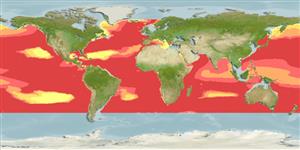>
Stomiiformes (Lightfishes and dragonfishes) >
Gonostomatidae (Bristlemouths)
Etymology: Cyclothone: Greek, kyklothen, in circle, around (Ref. 45335); microdon: microdon meaning small toothed (Ref. 6885).
More on author: Günther.
Environment: milieu / climate zone / depth range / distribution range
Ecología
marino batipelágico; rango de profundidad 200 - 5301 m (Ref. 58426), usually 500 - 2700 m (Ref. 82363). Deep-water; 67°N - 45°S, 180°W - 180°E
Widely distributed in all Atlantic, tropical and austral Indian and Pacific Oceans (Ref. 4463). Southern Ocean: probably circum-Antarctic between the Antarctic Polar Front and the Antarctic continental shelf (Ref. 5162).
Length at first maturity / Tamaño / Peso / Age
Maturity: Lm 3.3, range 3 - 3.5 cm
Max length : 7.6 cm TL macho / no sexado; (Ref. 4925)
Short description
Claves de identificación | Morfología | Morfometría
Espinas dorsales (total) : 0; Radios blandos dorsales (total) : 13 - 15; Espinas anales: 0; Radios blandos anales: 17 - 20. Brown to brown-black in color; dense stellate pigment over head, body and fins (Ref. 3991).
An oceanic, deep mesopelagic to bathypelagic species (Ref. 4769). Precise depth range dependent upon developmental stage, latitude, season (Ref. 4769). Doest not exhibit diel vertical migrations (Ref. 4769). A non-seasonal breeder with no recognizable age-cohorts (Ref. 82363). Feeds mainly on copepods (Ref. 4769).
Protandrous, sex reversal observed in the eastern North Atlantic (Ref. 5162). Sex reversal at 22-24 mm SL (Ref. 4769).
Quéro, J.-C., J.C. Njock and M.M. de la Hoz, 1990. Gonostomatidae. p. 283-292. In J.C. Quero, J.C. Hureau, C. Karrer, A. Post and L. Saldanha (eds.) Check-list of the fishes of the eastern tropical Atlantic (CLOFETA). JNICT, Lisbon; SEI, Paris; and UNESCO, Paris. Vol. 1. (Ref. 4463)
IUCN Red List Status (Ref. 130435: Version 2024-1)
Threat to humans
Harmless
Human uses
Pesquerías: sin interés
Herramientas
Special reports
Download XML
Fuentes de Internet
Estimates based on models
Preferred temperature (Ref.
123201): 1.8 - 8.2, mean 3.2 °C (based on 7820 cells).
Phylogenetic diversity index (Ref.
82804): PD
50 = 0.5001 [Uniqueness, from 0.5 = low to 2.0 = high].
Bayesian length-weight: a=0.00389 (0.00172 - 0.00881), b=2.99 (2.79 - 3.19), in cm total length, based on LWR estimates for this (Sub)family-body shape (Ref.
93245).
Nivel trófico (Ref.
69278): 3.0 ±0.13 se; based on food items.
Resiliencia (Ref.
120179): Medio, población duplicada en un tiempo mínimo de 1.4-4.4 años (Assuming tm>1; Fec=2,000-10,000).
Fishing Vulnerability (Ref.
59153): Low vulnerability (10 of 100).
